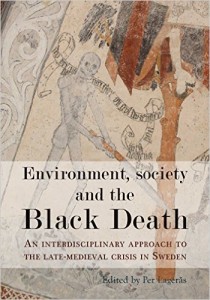Per Lagerås, ed.
Environment, Society, and the Black Death
(Casemate, 2016) 208 pp. £36.00
The subtitle of this book promises an interdisciplinary approach to the late-medieval crisis in Sweden that resulted from the outbreak of the black death, and it delivers on that promise. Not only does this book represent a strong dose of revisionist analysis that serves to support those Swedish historians who claim that the destruction in Sweden was on the same order of magnitude as that of other European nations during the late-medieval crisis, despite the comparative lack of written historical sources in Sweden as compared to areas like medieval England, but the approach taken by the authors is also one that shows the immense resourcefulness of researchers who wish to get at historical truth by a wide variety of immensely creative means.
It should be noted that in addition to positing a death rate of close to half of the population during the mid-14th century, the authors also demonstrate that the solution of the population was motivated by a significant amount of resilience and that it was not so much the crisis itself but the response to that crisis by medieval elites that led to a great deal of instability within Swedish society for some decades, a demonstration of how many techniques can combine for compelling research.
The book begins with a short preface and then an introductory section of three chapters that detail the interdisciplinary approach the book takes, state the current knowledge that exists on the late-medieval crisis brought on by the plague and that discuss the relationship between societal crisis and environmental change. The second part of the book follows with three chapters showing empirical studies about the late-medieval crisis, first looking at the selective abandonment of marginal farms in upland locations and the resulting agricultural change and ecology, an archaeological study of the late-medieval crisis as it related to change, desertion, and survival within Swedish cities and towns, and the study of burials and skeletons to examine living conditions in times of plague. The last four chapters of the book give conclusions in a wider perspective, starting with an examination of environment-society interactions dealing especially with questions of reforestation, a reflection on the research perspectives of the traumatic fourteenth century within Swedish historiography, a discussion of epidemics in a social context which demonstrated the resilience of Swedish culture despite the immense strain that it was under, and a brief summary of conclusions that give a fair flavor of the ambitions of the researchers: “We have focused on source materials and methods that are familiar to us and tried to make the conclusions accessible for readers of different background and interests. With this approach we wanted to introduce historians to these materials, and at the same time introduce palaeoecologists and archaeologists to the intriguing and complex research problems of the late-medieval crisis. Hence, in several respects this is an introductory study. With continued research based on a diversity of source materials and perspectives, the study of the late-medieval crisis can develop into a truly interdisciplinary endeavor.” (162)
Despite these modest claims, the book has a large number of resources that demonstrate a great deal of effort spent into providing as complete as analysis as possible, as well as a generous provision of statistical data for fellow researchers to pour over in testing the conclusions of the authors concerning the extent of death and the abandonment of farmsteads and resulting reforestation and other ecological changes as a result of the black death. To be sure, the analysis provided is based on a fairly small selection of sites, most of them in the southern part of Sweden, and very few sites north of Stockholm. For example, the study on the archaeology of the late-medieval crisis in Sweden only focused on three farmsteads, at Vålle, Stora Ullevi, and Örja, all of these locations being in the southern part of Sweden and all of them excavated within the last fifteen years (86). While the authors attribute this convenience selection to the sparsely populated nature of much of Sweden during the Middle Ages, it is to be hoped that further research will help to overcome the bias of much of the information to unrepresentative sites, which might allow for an understanding of regional differences in the response to and death resulting from the plague. As the authors state, the book is an introductory study and it ought to encourage further research and study by those historians and other scholars with interests in Swedish medieval history.
Of particular interest to students of Swedish political and military history relating to the Middle Ages is the conclusion by the authors that Sweden was not harmed so much by the dramatic effects of the plague itself, as serious as those were, but rather the unproductive reply of Sweden’s aristocratic elites to attempt to increase depredations and predation on Swedish commoners. The authors further state that the resulting decades of political instability fostered by such robber barons was only stopped by a strengthened Swedish monarchy that eventually enforced a fairer and more egalitarian rule starting in the 15th century, and that once the well-being of the ordinary people was better achieved through a well-functioning central government that the process of demographic recovery could then take place, although the results show that it was a considerable amount of time before Sweden reached the same population as it had before the late-medieval crisis. The initial plague, its recurrences, and the resulting social and demographic dislocation, had a truly massive effect on Sweden as it did throughout Europe, and this slim volume does a good job in showing how researchers can overcome a paucity in historical accounts with a focus on such evidence as is available through archaeology and ecological studies.
Nathan Albright
Norwich University

